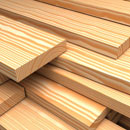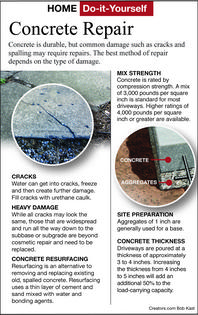Here's How: Make Some Concrete Repairs Yourself
Dear James: Some of the concrete around my landscaping and patio is deteriorating and needs repairs before it gets worse. What are some general concrete repair tips? -- Gretchen F.
Dear Gretchen: Making repairs to concrete is a relatively simple project. The most difficult part is carrying the heavy bags from your car to the work area. In this case, I recommend purchasing bags of premixed concrete instead of trying to mix your own. You just add water and carefully follow the instructions.
Concrete is simply a mixture of cement and an aggregate (sand and/or gravel). The cement is the glue that holds the entire mixture together. The addition of water to this mixture causes a chemical reaction to occur that solidifies the cement and the aggregate in it. It technically does not dry to get hard.
The ratio of cement to aggregate and the type(s) of aggregate used determine the strength of the cured concrete. For most landscaping and small repair jobs, any strength mixture is generally adequate.
In general, depending on the size of your job, consider using premixed concrete you can buy at most hardware stores and home centers. It is available with various types of aggregates, and the package usually indicates its recommended uses.
Premixed concrete can be purchased in bags small enough to lift out of your car trunk. Be careful, though, because even the small bags are much heavier than they appear, and it can be awkward and hard on your back to lift them out of a trunk.
For larger jobs, you should have a concrete company deliver wet concrete ready to pour. It is purchased in cubic yards, so calculate the volume you will need. Have several friends ready with wheelbarrows when the concrete truck arrives. You have a relatively short preset length of time to move the concrete from the truck to your project site.
Wear rubber gloves when working with concrete or any uncured cement-based materials. Although it may not hurt initially, cement is caustic so it will irritate and severely dry out your skin. Dry cement, even in unopened bags, is very dusty, so wear some coveralls or old jeans, too.
Almost any concrete job you will do requires that you build some type of form to hold the concrete until it cures. Forms are also important to make the concrete job level so that there are no puddles after a rain. If your concrete project will be against your house, slope the form slightly so rainwater flows away from the foundation.
Drive a few wooden stakes into the ground first at the location of the ends of a form side and one in the middle. Clamp the form to the stakes with C-clamps and check its slope. Once you have it adjusted properly, nail the form to the stakes and add more stakes in between them for support.
Wet the forms thoroughly and pour the wet concrete into them. When the form is full, use a tamper to tamp the wet concrete to compact it. Another method is to put rubber boots on your kids and have them walk around it in. Drag a straight two-by-four (used as a screed) over the forms to smooth and level the top of the concrete. Place grooves (expansion joints) in the partially cured concrete every 4 to 6 feet.
========
Send your questions to Here's How, 6906 Royalgreen Dr., Cincinnati, Ohio, 45244 or visit www.dulley.com. To find out more about James Dulley and read features by other Creators Syndicate writers and cartoonists, visit the Creators Syndicate website at www.creators.com.
Copyright 2025 Creators Syndicate Inc.






























Comments